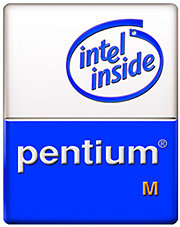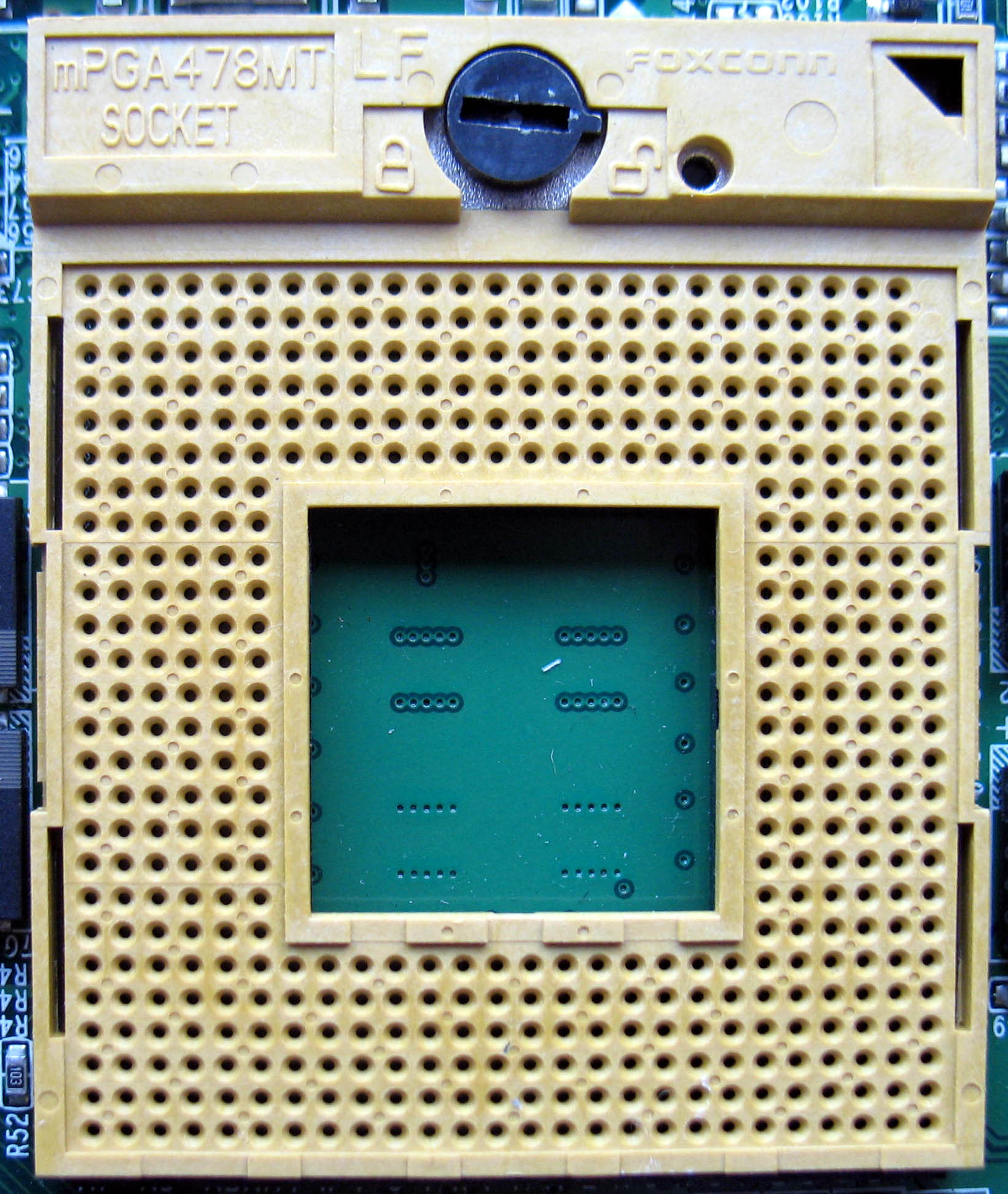|
Yonah (microprocessor)
Yonah was the code name of Intel's first generation 65 nm process CPU cores, based on cores of the earlier Banias (130 nm) / Dothan (90 nm) Pentium M microarchitecture. Yonah CPU cores were used within Intel's Core Solo and Core Duo mobile microprocessor products. SIMD performance on Yonah improved through the addition of SSE3 instructions and improvements to SSE and SSE2 implementations; integer performance decreased slightly due to higher latency cache. Additionally, Yonah included support for the NX bit. Models and brand names The Intel Core Duo brand referred to a low-power (less than 25 watts) dual-core microprocessor, which offered lower power operation than the competing AMD Opteron 260 and 860 HE at 55 watts. Core Duo was released on 5 January 2006, with the other components of the Napa platform. It was the first Intel processor to be used in Apple Macintosh products (although the Apple Developer Transition Kit machines, non-production units distribute ... [...More Info...] [...Related Items...] OR: [Wikipedia] [Google] [Baidu] |
Pentium M
The Pentium M is a family of mobile 32-bit single-core x86 microprocessors (with the modified Intel P6 microarchitecture) introduced in March 2003 and forming a part of the Intel Carmel notebook platform under the then new Centrino brand. The ''Pentium M'' processors had a maximum thermal design power (TDP) of 5–27 W depending on the model, and were intended for use in laptops (thus the "M" suffix standing for ''mobile''). They evolved from the core of the last Pentium III–branded CPU by adding the front-side bus (FSB) interface of Pentium 4, an improved instruction decoding and issuing front end, improved branch prediction, SSE2 support, and a much larger cache. The first Pentium M–branded CPU, code-named Banias, was followed by Dothan. The Pentium M line was removed from the official price lists in July 2009, when the Pentium M-branded processors were succeeded by the Core-branded dual-core mobile Yonah CPU with a modified microarchitecture. It replaced the Mobile Penti ... [...More Info...] [...Related Items...] OR: [Wikipedia] [Google] [Baidu] |
Socket M
Socket M (mPGA478MT) is a CPU interface introduced by Intel in 2006 for the Intel Core line of mobile processors. Technical specifications Socket M is used in all Intel Core products, as well as the Core-derived Dual-Core Xeon codenamed Sossaman. It was also used in the first generation of the mobile version of Intel's Core 2 Duo, specifically, the T5x00 and T7x00 Merom lines (referred to as Napa Refresh), though that line switched to Socket P (Santa Rosa) in 2007. It typically uses the Intel 945PM/945GM chipsets which support up to 667 MHz FSB and the Intel PM965/GM965 which allows 800 MHz FSB support, though the Socket M, PM965/GM965 combination is less common. The "Sossaman" Xeons use the E7520 chipset. Relation to other sockets Socket M is pin-compatible with desktop socket mPGA478A but it is not electrically compatible. Socket M is not pin-compatible with the older desktop Socket 478 (mPGA478B) or the newer mobile Socket P The Intel Socket P (mPGA478MN) is th ... [...More Info...] [...Related Items...] OR: [Wikipedia] [Google] [Baidu] |
Centrino
Centrino is a brand name of Intel Corporation which represents its Wi-Fi and WiMAX wireless computer networking adapters. Previously the same brand name was used by the company as a platform-marketing initiative. The change of the meaning of the brand name occurred on January 7, 2010. The Centrino was replaced by the Ultrabook. The old platform-marketing brand name covered a particular combination of mainboard chipset, mobile CPU and wireless network interface in the design of a laptop. Intel claimed that systems equipped with these technologies delivered better performance, longer battery life and broader wireless network interoperability than non-Centrino systems. The new product line name for Intel wireless products is Intel Centrino Wireless. Intel Centrino Notebook implementations Carmel platform (2003) Intel used "Carmel" as the codename for the first-generation Centrino platform, introduced in March 2003. Industry-watchers initially criticized the Carmel platform ... [...More Info...] [...Related Items...] OR: [Wikipedia] [Google] [Baidu] |
Transistor
upright=1.4, gate (G), body (B), source (S) and drain (D) terminals. The gate is separated from the body by an insulating layer (pink). A transistor is a semiconductor device used to Electronic amplifier, amplify or electronic switch, switch electrical signals and electrical power, power. The transistor is one of the basic building blocks of modern electronics. It is composed of semiconductor material, usually with at least three terminals for connection to an electronic circuit. A voltage or current applied to one pair of the transistor's terminals controls the current through another pair of terminals. Because the controlled (output) power can be higher than the controlling (input) power, a transistor can amplify a signal. Some transistors are packaged individually, but many more are found embedded in integrated circuits. Austro-Hungarian physicist Julius Edgar Lilienfeld proposed the concept of a field-effect transistor in 1926, but it was not possible to actually constru ... [...More Info...] [...Related Items...] OR: [Wikipedia] [Google] [Baidu] |
List Of Intel Celeron Microprocessors
A ''list'' is any set of items in a row. List or lists may also refer to: People * List (surname) Organizations * List College, an undergraduate division of the Jewish Theological Seminary of America * SC Germania List, German rugby union club Other uses * Angle of list, the leaning to either port or starboard of a ship * List (information), an ordered collection of pieces of information ** List (abstract data type), a method to organize data in computer science * List on Sylt, previously called List, the northernmost village in Germany, on the island of Sylt * ''List'', an alternative term for ''roll'' in flight dynamics * To ''list'' a building, etc., in the UK it means to designate it a listed building that may not be altered without permission * Lists (jousting), the barriers used to designate the tournament area where medieval knights jousted * ''The Book of Lists'', an American series of books with unusual lists See also * The List (other) * Listing (di ... [...More Info...] [...Related Items...] OR: [Wikipedia] [Google] [Baidu] |
List Of Intel Pentium Microprocessors
The Intel Pentium brand is a line of mainstream x86-architecture microprocessors from Intel. Processors branded Pentium Processor with MMX Technology (and referred to as Pentium MMX for brevity) are also listed here. Desktop processors P5 based Pentiums "P5" (0.8 μm) * Based on P5 * Steppings: B1, C1, D1 "P54C" (0.6 μm) * Based on P5 microarchitecture "P54CQS" (0.35 μm or 0.6 μm) * Based on P5 microarchitecture "P54CS" (0.35 μm) * Based on P5 microarchitecture "P55C" (0.35 μm) * Based on P5 microarchitecture P6 based Pentiums Desktop processors based on the P6 microarchitecture were marketed as Pentium Pro, Pentium II and Pentium III, as well as variations of these names. NetBurst based Pentiums Desktop processors based on the NetBurst microarchitecture were marketed as Pentium 4 and Pentium D. Core based Pentiums Earlier E5xxx desktop processors based on the Core microarchitecture were marketed as Pentium ... [...More Info...] [...Related Items...] OR: [Wikipedia] [Google] [Baidu] |
List Of Intel Core Microprocessors
The following is a list of Intel Core microprocessors. Core Core 2 1st generation 2nd generation 3rd generation 4th generation 5th generation 6th generation 7th generation 8th generation 9th generation 10th generation 11th generation 12th generation 13th generation See also * Enhanced Pentium M (microarchitecture) * List of Intel Pentium M microprocessors * List of Intel Pentium processors * Comparison of Intel processors References External links Intel Core Solo mobile processor product order code tableSearch MDDS DatabaseIntel ARK DatabaseIntel Core Duo Processor and Core Solo Processor on 65 nm Process DatasheetIntel Core Duo Processor and Core Solo Processor on 65 nm Process Specification Update{{Intel processors, p6 *Core Intel Core Intel Core is a line of streamlined midrange consumer, workstation and enthusiast computer central processing units (CPUs) marketed by Intel Corp ... [...More Info...] [...Related Items...] OR: [Wikipedia] [Google] [Baidu] |
Thermal Design Power
The thermal design power (TDP), sometimes called thermal design point, is the maximum amount of heat generated by a computer chip or component (often a CPU, GPU or system on a chip) that the cooling system in a computer is designed to dissipate under any workload. Some sources state that the peak power rating for a microprocessor is usually 1.5 times the TDP rating. Intel has introduced a new metric called ''scenario design power'' (SDP) for some Ivy Bridge Y-series processors. Calculation The ''average CPU power'' (ACP) is the power consumption of central processing units, especially server processors, under "average" daily usage as defined by Advanced Micro Devices (AMD) for use in its line of processors based on the K10 microarchitecture ( Opteron 8300 and 2300 series processors). Intel's thermal design power (TDP), used for Pentium and Core 2 processors, measures the energy consumption under high workload; it is numerically somewhat higher than the "average" ACP rat ... [...More Info...] [...Related Items...] OR: [Wikipedia] [Google] [Baidu] |
SpeedStep
Enhanced SpeedStep is a series of dynamic frequency scaling technologies (codenamed Geyserville and including SpeedStep, SpeedStep II, and SpeedStep III) built into some Intel microprocessors that allow the clock speed of the processor to be dynamically changed (to different ''P-states'') by software. This allows the processor to meet the instantaneous performance needs of the operation being performed, while minimizing power draw and heat generation. EIST (SpeedStep III) was introduced in several Prescott 6 series in the first quarter of 2005, namely the Pentium 4 660. Intel Speed Shift Technology (SST) was introduced in Intel Skylake Processor. Enhanced Intel SpeedStep Technology is sometimes abbreviated as EIST. Intel's trademark of "INTEL SPEEDSTEP" was cancelled due to the trademark being invalidated in 2012. Explanation Running a processor at high clock speeds allows for better performance. However, when the same processor is run at a lower frequency (speed), it generates ... [...More Info...] [...Related Items...] OR: [Wikipedia] [Google] [Baidu] |
Physical Address Extension
In computing, Physical Address Extension (PAE), sometimes referred to as Page Address Extension, is a memory management feature for the x86 architecture. PAE was first introduced by Intel in the Pentium Pro, and later by AMD in the Athlon processor. It defines a page table hierarchy of three levels (instead of two), with table entries of 64 bits each instead of 32, allowing these CPUs to directly access a physical address space larger than 4 gigabytes (232 bytes). The page table structure used by x86-64 CPUs when operating in long mode further extends the page table hierarchy to four levels, extending the virtual address space, and uses additional physical address bits at all levels of the page table, extending the physical address space. It also uses the topmost bit of the 64-bit page table entry as a no-execute or "NX" bit, indicating that code cannot be executed from the associated page. The NX feature is also available in protected mode when these CPUs are running a 32- ... [...More Info...] [...Related Items...] OR: [Wikipedia] [Google] [Baidu] |
AMD Quad FX
The AMD Quad FX platform is an AMD platform targeted at enthusiasts which allows users to plug two Socket F Athlon 64 FX or 2-way Opteron processors (CPUs) into a single motherboard for a total of four physical cores. This is a type of dual processor setup, where two CPUs are installed on a motherboard to increase computing power. The major difference between the platform and past dual processor systems like Xeon (pre Intel 5000X/P chipset) is that each processor has its own dedicated memory stores. The Quad FX platform also has HyperTransport capability targeted toward consumer platforms. In May 2007, AMD officially codenamed the eight core setup with two Phenom FX processors to be the ''FASN8'' (pronounced as "fascinate", , in short for ''First AMD Silicon Next-gen 8-core Platform'') from the previous codename "''4x4+''" used in Analyst Day presentations. Configuration In each socket resides an AMD Athlon 64 FX CPU. Each socket is connected using AMD's Direct Chip Module, t ... [...More Info...] [...Related Items...] OR: [Wikipedia] [Google] [Baidu] |
Xeon
Xeon ( ) is a brand of x86 microprocessors designed, manufactured, and marketed by Intel, targeted at the non-consumer workstation, server, and embedded system markets. It was introduced in June 1998. Xeon processors are based on the same architecture as regular desktop-grade CPUs, but have advanced features such as support for ECC memory, higher core counts, more PCI Express lanes, support for larger amounts of RAM, larger cache memory and extra provision for enterprise-grade reliability, availability and serviceability (RAS) features responsible for handling hardware exceptions through the Machine Check Architecture. They are often capable of safely continuing execution where a normal processor cannot due to these extra RAS features, depending on the type and severity of the machine-check exception (MCE). Some also support multi-socket systems with two, four, or eight sockets through use of the Ultra Path Interconnect (UPI) bus. Overview The ''Xeon'' brand has been mainta ... [...More Info...] [...Related Items...] OR: [Wikipedia] [Google] [Baidu] |



.jpg)

